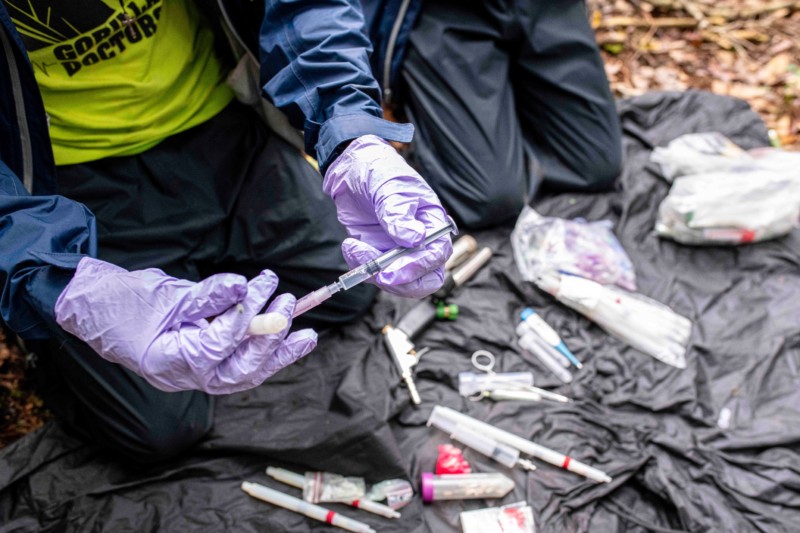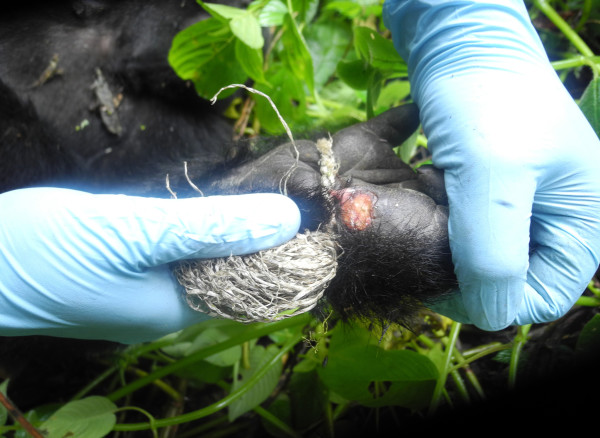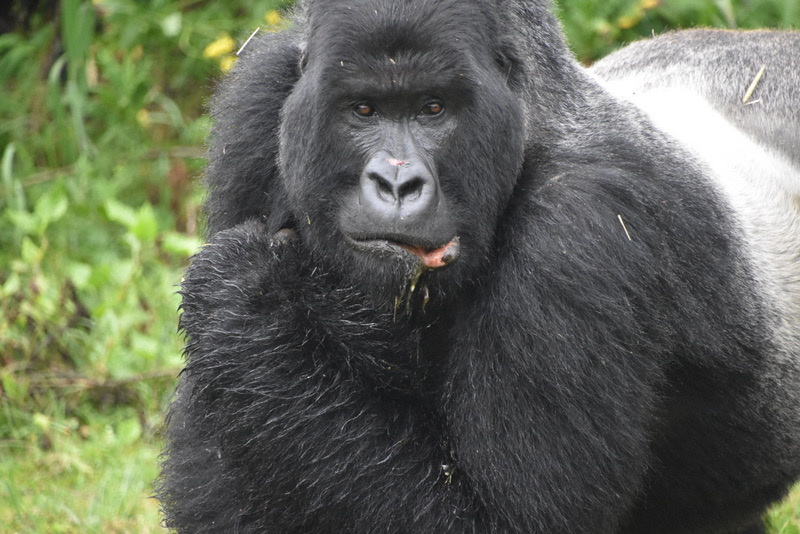Disease and Trauma in Gorillas
Gorilla Health Threat:
Infectious Diseases
Due to the genetic similarity between humans and gorillas, gorillas are susceptible to many of the same infectious diseases that affect people, including SARS-CoV-2, the virus causing COVID-19. The parks where the mountain and Grauer’s gorillas live are surrounded by the densest human populations in continental Africa. While gorilla ecotourism ultimately helps conserve gorillas by providing the critical funding needed to protect and manage the national parks, it brings thousands of people from the local communities and from around the world into contact with mountain gorillas.
Through ranger-based monitoring and the veterinary team’s routine health checks, gorillas showing signs of respiratory disease—runny nose, coughing, lethargy—are flagged for more intensive observation. Most gorillas with respiratory disease recover on their own, but others deteriorate and develop secondary bacterial infections, causing even more severe respiratory disease, like bronchopneumonia, which can be fatal. Fortunately, bacterial infections can be treated if caught early enough.
When it becomes apparent that a gorilla has a severe respiratory infection and is not improving, the Gorilla Doctors will stage a medical intervention to dart the individual with antibiotics. Usually, a single darted injection of a powerful antibiotic such as ceftriaxone is enough to help most gorillas recover, but sometimes a second dose is required a few days after the first darting.
In dire cases, the gorilla may be darted with an anesthetic drug so that the Gorilla Doctors can conduct a thorough physical examination, administer intravenous fluids and antimicrobials, and obtain diagnostic samples. During such interventions, samples are taken so that the exact cause of the disease can be identified. Knowing the precise cause of the infection helps inform the Gorilla Doctors’ medical decisions when dealing with future disease outbreaks. Samples are stored in a biobank for evaluation by researchers studying gorilla health issues.

Our Hospital is the Forest: Dr. Fred prepares to dart a sick mountain gorilla in Bwindi Impenetrable National Park, Uganda, 2020.
Gorilla Health Threat:
Snares
Rope and wire snares set by poachers in the national parks pose a great threat to the gorillas. In general, poachers set snares to catch antelope and other forest animals in order to feed their families. The land surrounding mountain gorilla habitat is some of the most densely populated in Africa, and most of the population is extremely poor. The pressure for food is enormous and some people turn to poaching to survive.
Unfortunately, gorillas, especially infants and juveniles, sometimes get caught in these snares. Gorillas may lose limbs or digits to snares, or die as a result of infection or strangulation.

When a gorilla is reported with a snare, the Gorilla Doctors intervene as soon as possible. An intervention team comprised of several veterinarians, national park staff members, and trackers and porters hike to find the ensnared gorilla and make an evaluation of the situation. In order for the team to safely approach the animal and treat its wound, the gorilla must be darted with an anesthetic drug.
Chemically immobilizing an ensnared gorilla can be complicated. If the affected gorilla is young and being carried by its mother, the mother must also be darted because she will not willingly give her up baby otherwise. The mother and baby must be darted simultaneously with two different dart guns, so it is challenging to find an opportunity to safely dart both. Whether darting one or two animals, it is necessary for the veterinarian doing the darting to hide behind two trackers so that the gorillas do not see the dart gun. The gorillas recognize guns and quickly flee if they spot one.
All veterinary care for wild human-habituated gorillas is delivered in the forest; gorillas are not removed from the wild, even temporarily, in order to facilitate treatment.
Gorilla Health Threat:
Gorilla-Inflicted Trauma
Physical injury or trauma is the leading cause of death in mountain gorillas. Trauma can be human-induced (such as injuries caused by snares), the result of accidents, or caused by other gorillas. When taking over a group or acquiring new females, silverbacks sometimes commit infanticide on the other male’s infants, so that their mothers will start reproductively cycling again, enabling the new males to father their own offspring with the females. Silverbacks and blackbacks, with their long, sharp canine teeth, can inflict serious injuries when fighting with each other for dominance. Occasionally, adult females and youngsters get caught in the middle of fights and are injured.
While infanticide and fighting are natural occurrences in the gorilla population, the Gorilla Doctors will sometimes intervene to save individuals suffering from life-threatening injuries. Geneticists believe that because the mountain gorilla population is so small and genetic diversity is vital to the species’ survival, that individual gorillas contributing to the gene pool warrant life-saving veterinary care.
Our veterinary team continues to examine and debate the complicated issue of intervening to save gorillas suffering from wounds inflicted naturally by other gorillas. We look forward to the day when the mountain gorilla population is large enough that there is no longer the need to intervene.

Silverback Gihishamwotsi of Sabyinyo group, Volcanoes National Park, Rwanda recovering from a severe lip laceration following an inter-group interaction. READ the full story of his extraordinary recovery.


 Donate
Donate